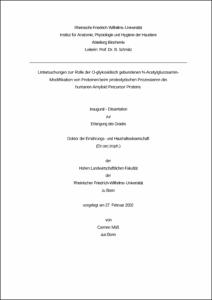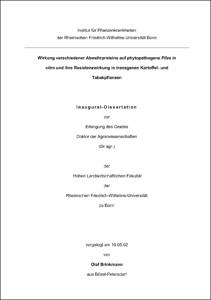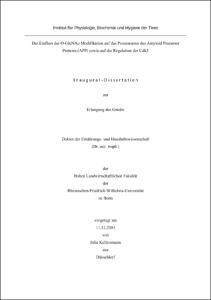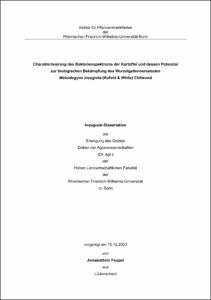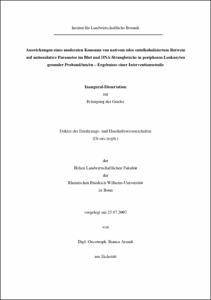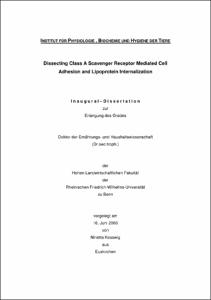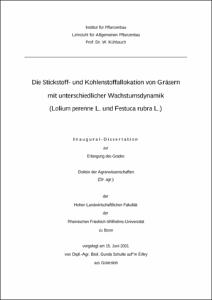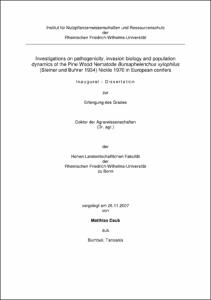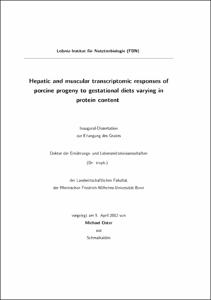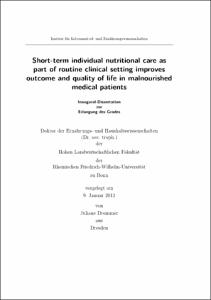E-Dissertationen: Search
Now showing items 1-10 of 64
Untersuchungen zur Rolle der O-glykosidisch gebundenen N-Acetylglucosamin-Modifikation von Proteinen beim proteolytischen Prozessieren des humanen Amyloid Precursor Proteins
(2002)
Das Amyloid Precursor Protein (APP) spielt eine zentrale Rolle bei der Pathogenese der Alzheimer Demenz (AD). APP wird durch die sog. α-, β- und γ-Sekretase zu verschiedenen proteolytischen Fragmenten gespalten. Diese ...
Wirkung verschiedener Abwehrproteine auf phytopathogene Pilze in vitro und ihre Resistenzwirkung in transgenen Kartoffel- und Tabakpflanzen
(2004)
Die Entwicklung von Transformations- und Klonierungstechniken eröffnet neue Wege in der Züchtung von Kulturpflanzen. Durch diese Verfahren wird es möglich, Gene aus verschiedenen Organismen in Pflanzen zu exprimieren. Ziel ......
Effect of several resistance proteins on phytopathogenic fungi in vitro and the resistance effect of these proteins in transgenic potato and tobacco plants
The development of plant transformation and ......
Effect of several resistance proteins on phytopathogenic fungi in vitro and the resistance effect of these proteins in transgenic potato and tobacco plants
The development of plant transformation and ......
Der Einfluss der O-GlcNAc-Modifikation auf das Prozessieren des Amyloid Precursor Proteins (APP) sowie auf die Regulation der Cdk5
(2004)
O-glykosidisch gebundenes N-Acetylglucosamin (O-GlcNAc) an Serin- und Threoninresten von Proteinen ist eine posttranslationale Modifikation von cytosolischen Proteinen, Kernproteinen und cytoplasmatischen Domänen von ...
Charakterisierung des Bakterienspektrums der Kartoffel und dessen Potenzial zur biologischen Bekämpfung des Wurzelgallennematoden Meloidogyne incognita (Kofoid & White) Chitwood
(2004)
Pflanzenassoziierte Bakterien können zum Pflanzenwachstum und zur Pflanzengesundheit beitragen, jedoch ist bisher wenig über ihre Abundanz, Diversität und ihr antagonistisches Potenzial zur biologischen Kontrolle bodenbürtiger ...
Auswirkungen eines moderaten Konsums von nativem oder entalkoholisiertem Rotwein auf antioxidative Parameter im Blut und DNA-Strangbrüche in peripheren Leukozyten gesunder Proband/inn/en: Ergebnisse einer Interventionsstudie
(2003)
Rotwein ist reich an antioxidativen Polyphenolen, die möglicherweise oxidativem Stress in vivo entgegenwirken und damit vor verschiedenen Erkrankungen wie Herz-Kreislauf-, Krebs- oder chronisch entzündlichen ...
Dissecting Class A Scavenger Receptor Mediated Cell Adhesion and Lipoprotein Internalization
(2003)
Macrophage Class A scavenger receptors (SR-A) are trimeric transmembrane glycoproteins that can bind a variety of ligands including modified lipoproteins and bacterial products. Through its ability to internalize these ...
Die Stickstoff- und Kohlenstoffallokation von Gräsern mit unterschiedlicher Wachstumsdynamik (Lolium perenne L. und Festuca rubra L.)
(2001)
Die Artenzusammensetzung von Grünlandbeständen wird von Standort-, Klima- und Bodenbedingungen beeinflußt. Vor allem eine höhere Intensität der Stickstoffdüngung führt zu einer Verschiebung des Artenspektrums hin zu ......
The Nitrogen and Carbon Allocation of Grasses with differing Growth Dynamics (Lolium perenne L. und Festuca rubra L.)
The species composition on permanent grassland is influenced by environmental ......
The Nitrogen and Carbon Allocation of Grasses with differing Growth Dynamics (Lolium perenne L. und Festuca rubra L.)
The species composition on permanent grassland is influenced by environmental ......
Investigations on pathogenicity, invasion biology and population dynamics of the Pine Wood Nematode Bursaphelenchus xylophilus (Steiner und Buhrer 1934) Nickle 1970 in European conifers
(2008)
The objectives of the present study were to identify potential European host trees for the Pine Wood Nematode (PWN) and to investigate the interrelationship between PWN, host trees and temperature.
Inoculation ......
Inoculation ......
Untersuchungen zur Pathogenität, Invasionsbiologie und Populationsdynamik des Kiefernholznematoden Bursaphelenchus xylophilus (Steiner und Buhrer 1934) Nickle 1970 in Europäischen Koniferen
Ziel ......
Hepatic and muscular transcriptomic responses of porcine progeny to gestational diets varying in protein content
(2012-10-12)
Inadequate maternal protein supply during gestation represents an environmental factor that is known to affect physiological signaling pathways and impacts the phenotype of the progeny in animal models and in humans with ...
Short-term individual nutritional care as part of routine clinical setting improves outcome and quality of life in malnourished medical patients
(2012-11-12)
Nutritional strategies to treat malnutrition are rare and lack practicability in the hospital setting. This study aims at providing nutritional risk patients with individual nutrition care in order to raise energy and ...


